Home » Other Articles » Tuesday Treasures Index » Tuesday Treasures - November 2023 - Tuesday Treasures - November 2023
Tuesday Treasures - November 2023
TUESDAY 28 NOVEMBER
A ‘Land Cruise’ to the North Cornish Coast
This week we hark back to 1957 when nearly ten years of nationalisation had barely touched the railways of the West of England. A handbill from the collection of the late Alastair Jeffery, the Land Cruise featured here is very similar to the type of tours that were run in the inter-war years and although a BR (Western Region) promotion, it ran for many miles over the old Southern Railway’s ‘Withered Arm’. All for twenty quid in modern terms, great value then and indeed now.

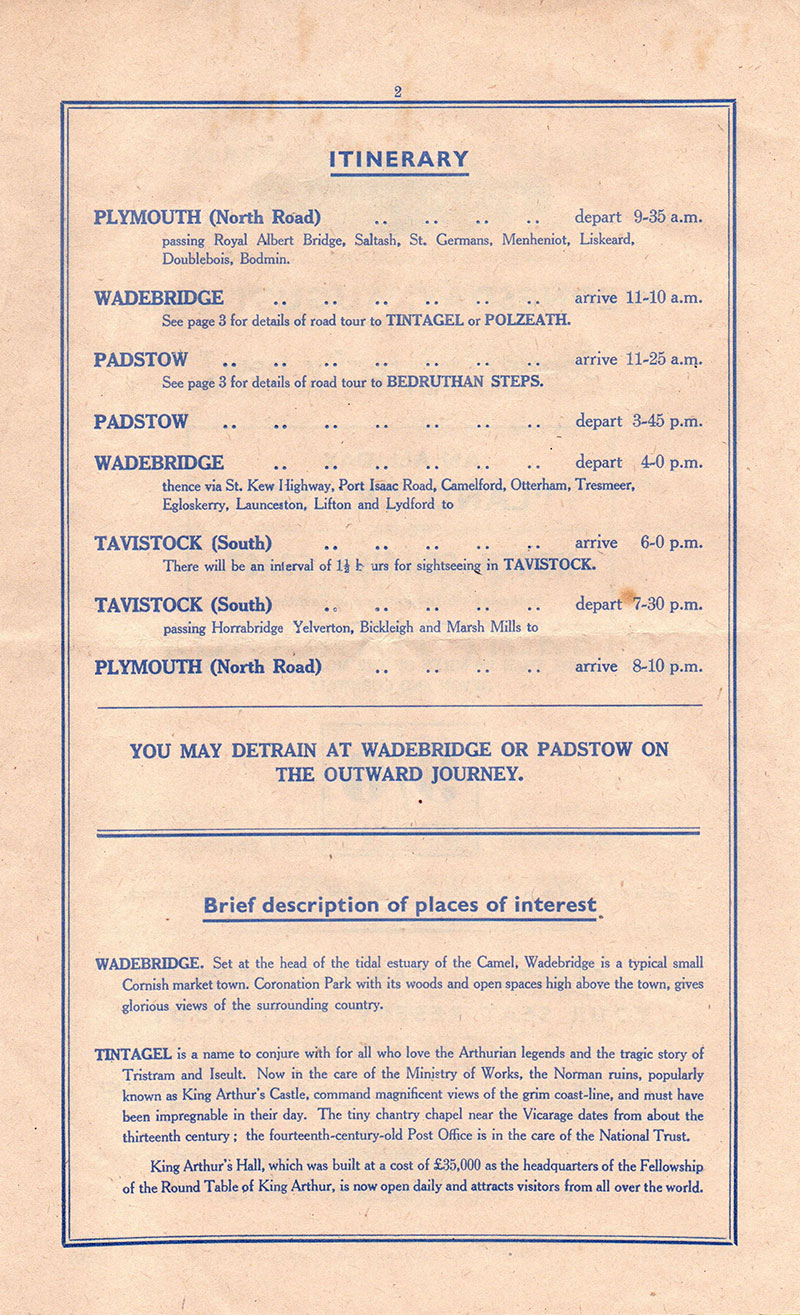
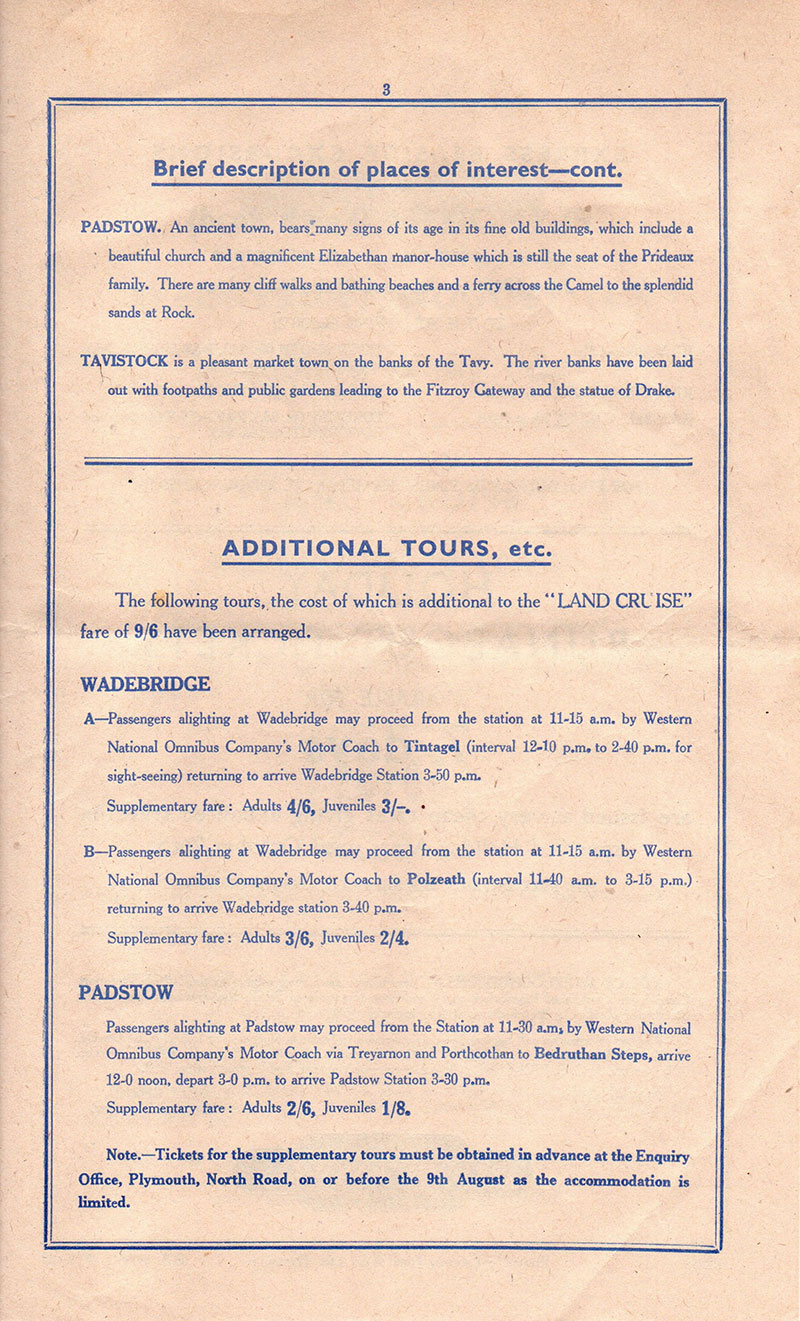
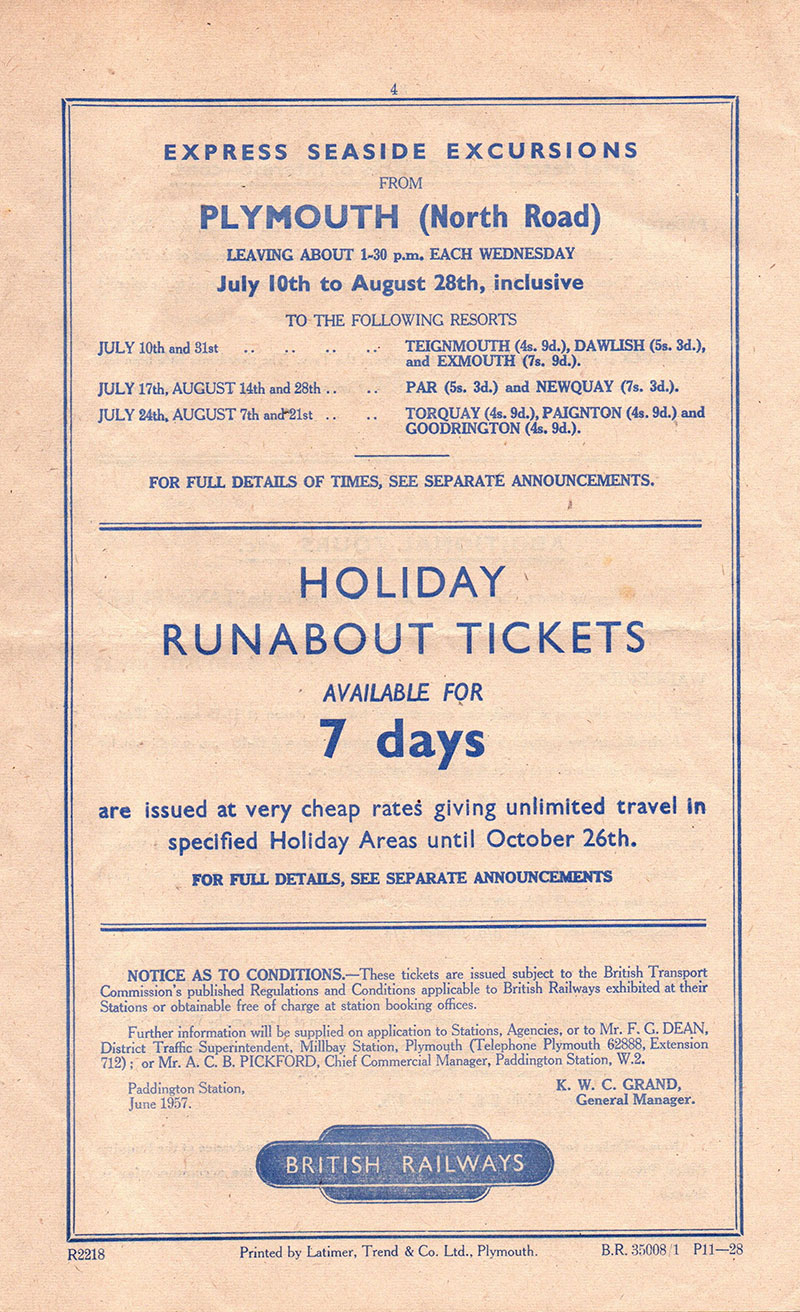
The day began with a 9.35 am departure from Plymouth and running down the Cornish main line as far Bodmin Road traversed the branch to reach Bodmin General. After reversing there the train joined the Southern Region for the journey to Wadebridge and Padstow. Following a four-hour lunch break (no Rick Stein restaurants in 1957), the return journey was again on Southern metals to Launceston, thence the GWR route back to Plymouth via Tavistock and Yelverton. We cannot be sure where the train rejoined the Western Region, either at Launceston (see the recent Tuesday Treasure of 7th November) or Lydford, there were connections at both locations. Perhaps someone out there has photographic evidence.
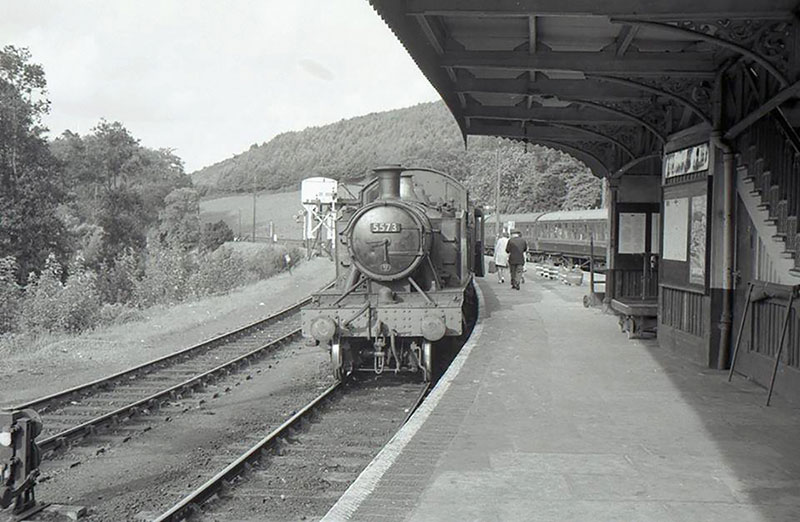
Bodmin Road in 1961 with 2-6-2T No 5573 in charge of the branch line train to Bodmin General
Day excursions such as these were easy to arrange in the days when railways criss-crossed the country and spare rolling stock was held in reserve for just such occasions. On page four there are seaside excursions advertised on eight consecutive Wednesdays throughout the summer.

The Southern Region’s Wadebridge station with a Western Region train to Bodmin on the left
Within a decade, the West of England railway scene would have changed beyond recognition.
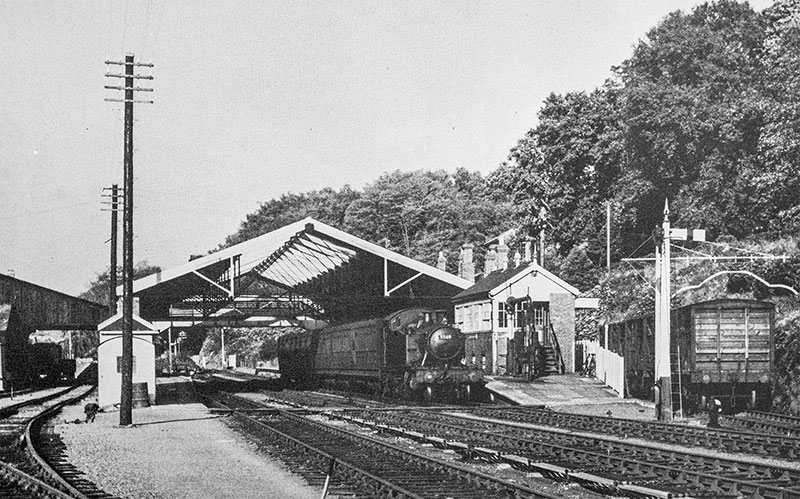
Tavistock South station in October 1953 with a train to Plymouth North Road hauled by 2-6-2T No 5569. Photograph by R E Vincent
TUESDAY 21 NOVEMBER
A VIP Special Train
Today, from the Great Western Trust Archive we look back to Thursday 16 October 1958 when the BRWR officers and train operating staff had to be on their toes as their then Minister of Transport and Civil Aviation, Mr Harold Watkinson, hosted a VIP visit to the Atomic Energy Research Establishment at Harwell for Ministers of Transport who were attending their European Conference in the UK.
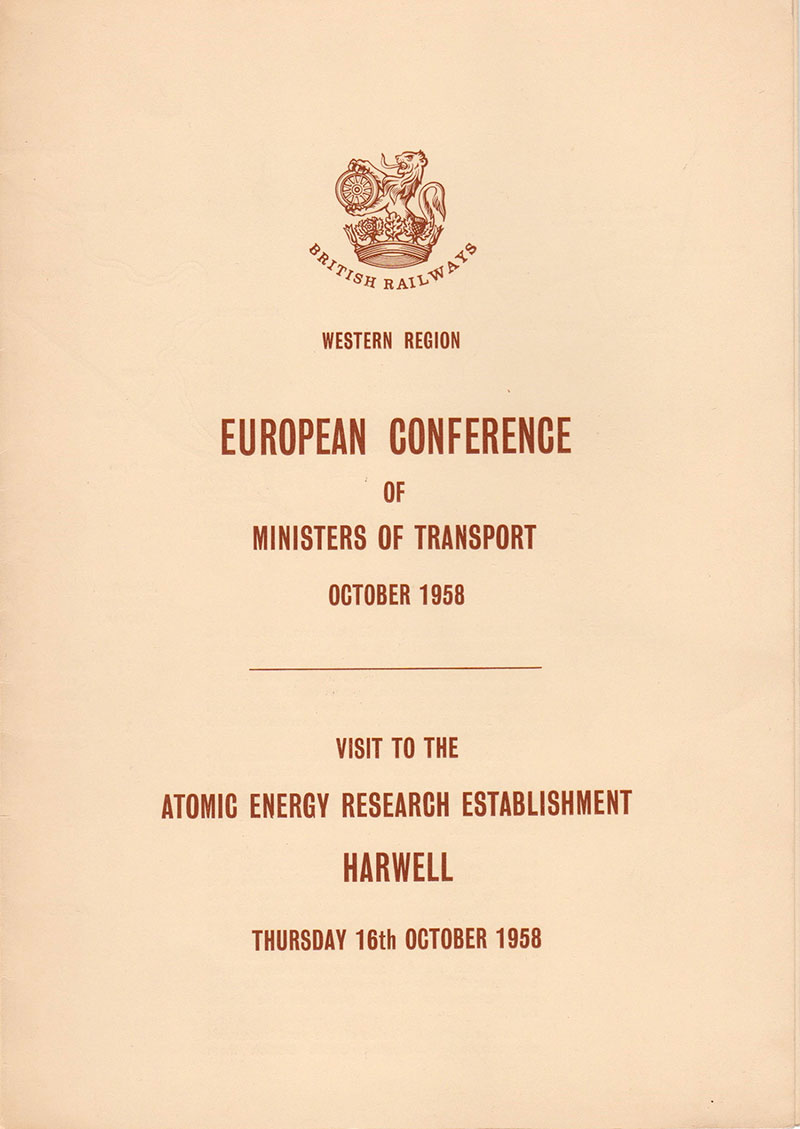
To manage the visit, BRWR provided a train from Paddington to Didcot and a quality card programme for the journey that we illustrate in two images. The first being its simple but stylish cover, and the second the image and text of the D800 Sir Brian Robertson extolling its UK construction at Swindon and how it will transform the transition of services from steam.

The programme itself also contained a most informative route map with significant text on the respective aspects of key stations and places of interest on the route. Such travel guides were a long established product of the Great Western Railway, and the Trust holds a very special example created by a GWR staff member at the specific request of Queen Mary in August 1927 for her journey from Paddington to Yorton near Shrewsbury.
We may rather wonder quite why the European Transport Ministers were content to have such an ‘Away Day’ visit, but whilst modernisation of railway locomotive engineering was much in vogue at the time, a rather over optimistic publication once speculated that future railway locomotives might be nuclear powered!
The then Minister, Harold Watkinson had but one year to remain in post before the Prime Minister, Harold Macmillan replaced him in October 1959 by Ernest Marples, and we all now know how he acted and his ultimate fall from grace when he left the UK in rather a hurry, never to return so as to avoid the long and ineffectual arm of the law!
MUST we pass through Didcot?
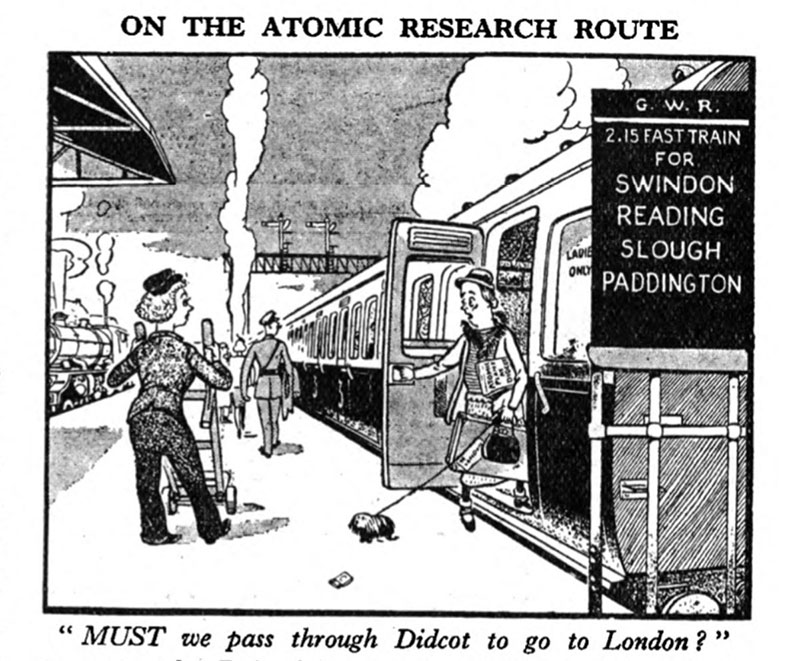
The announcement in October 1945 that the Atomic Energy Research Establishment was to be located at Harwell, close to Didcot, caused a great deal of consternation to a population who were only too well aware of the destructive effects of atomic bombs. The first cartoon here, by Roland Davies, was published in the Sunday Dispatch and reprinted in the Great Western Railway Magazine, December 1945 edition. The second cartoon, by the legendary Giles, was published in the Daily Express on 31 October 1945.
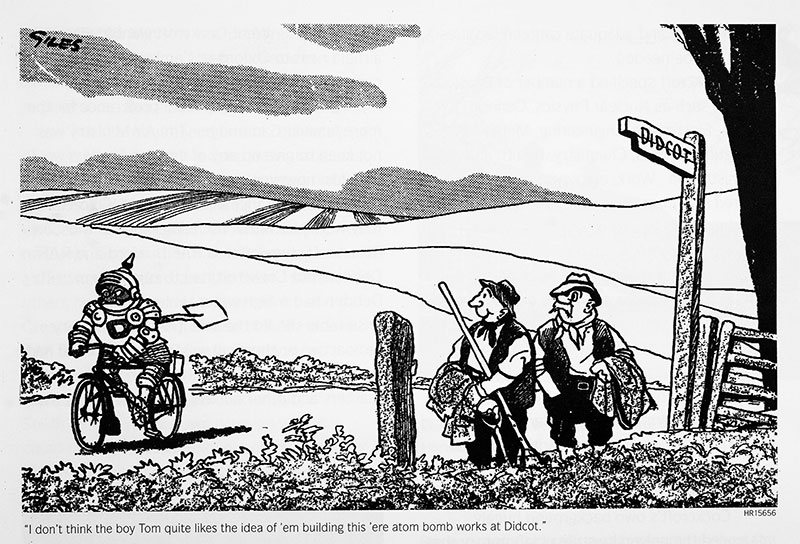
TUESDAY 14 NOVEMBER
In the Great Western Trust collection of documents relating to Great Western Society (GWS) history are two notices of the first moves of GWS locomotives and rolling stock to Didcot engine shed in November and December 1967.
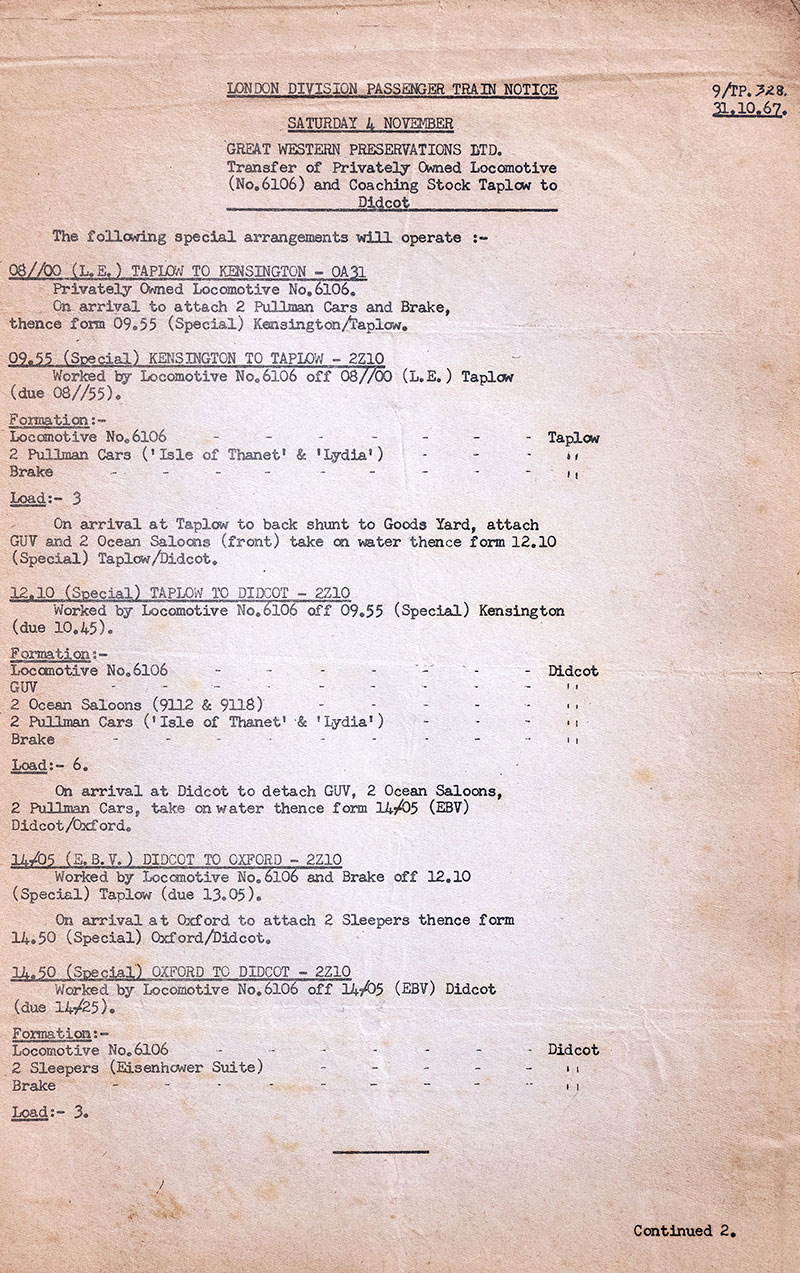

The first illustrated here is the train notice for the move on Saturday 4 November 1967 of No 6106 and two ocean saloons from Taplow. The reverse is signed by David Pattisson, the London Divisional Manager who had offered use of Didcot engine shed to the GWS.
2-6-2T locomotive No 6106 had been resident in Taplow goods shed for about 18 months, and had to move because the goods shed was to be demolished. Despite British Rail having announced a week beforehand that it was to cease running all steam-hauled specials, 6106 was permitted to make several journeys on that historic Saturday.
The first move was to Kensington Olympia, via the triangle at Slough, formed by the east and west curves to the Windsor branch line, to turn the locomotive. The west curve of the Windsor branch had rarely been used, except for excursion and royal trains, and had ostensibly been closed in 1964. Now running bunker first, 6106 continued to Kensington Olympia to pick up two Pullman coaches, ‘Lydia’ and ‘Isle of Thanet’, which had been part of Winston Churchill’s funeral train in January 1965. These were destined for storage at Didcot before going to the USA for preservation.
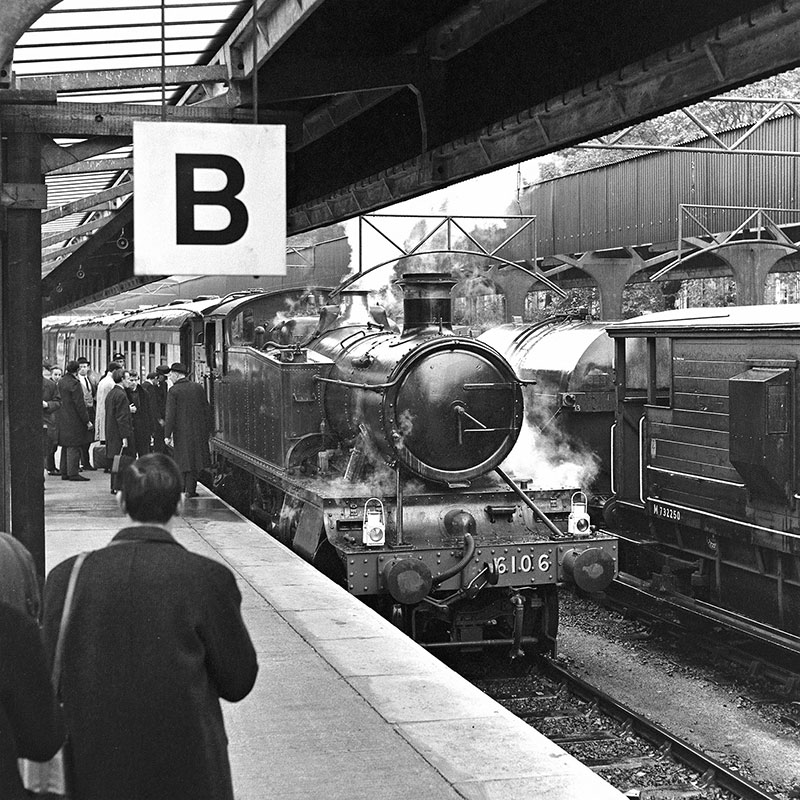
No 6106 with the Pullmans at Kensington Olympia on 4 November 1967. This was a particularly delicious visit because Olympia was at the time a Western Region London terminus while Paddington station was undergoing major track reconstruction
6106 then returned to Taplow with the Pullmans and reversed into the goods yard to pick up two Ocean saloons, Nos 9112 and 9118, and a van full of tools and spare parts. The complete train headed to Didcot.

No 6106 and train in Sonning cutting on 4 November 1967. The vehicles are a BR GUV (general utility van), Ocean Saloons 9112 and 9118, Pullman cars Lydia and Isle of Thanet, and a BR brake second coach
But the day’s work was not yet finished because No 6106 then ran to Oxford to pick up two London & North Eastern Railway sleeping cars which had been used in General Eisenhower’s wartime train. These were brought back to Didcot where they were stored for a short time before accompanying the Pullmans to the USA. The sleeping cars remain there, while the Pullmans have since been repatriated to the UK.

Four weeks later a motley train ran from Plymouth to Didcot on Saturday 2 December 1967. Arranged hastily before the curtain finally came down on steam-hauled specials, the timing sheet in the Great Western Trust collection shows it took nearly ten hours for the 200 mile journey, punctuated by regular water stops. 100 passengers were allowed to travel, with the advice to wrap up warm in case the steam heat failed, and to take their own food and drink.
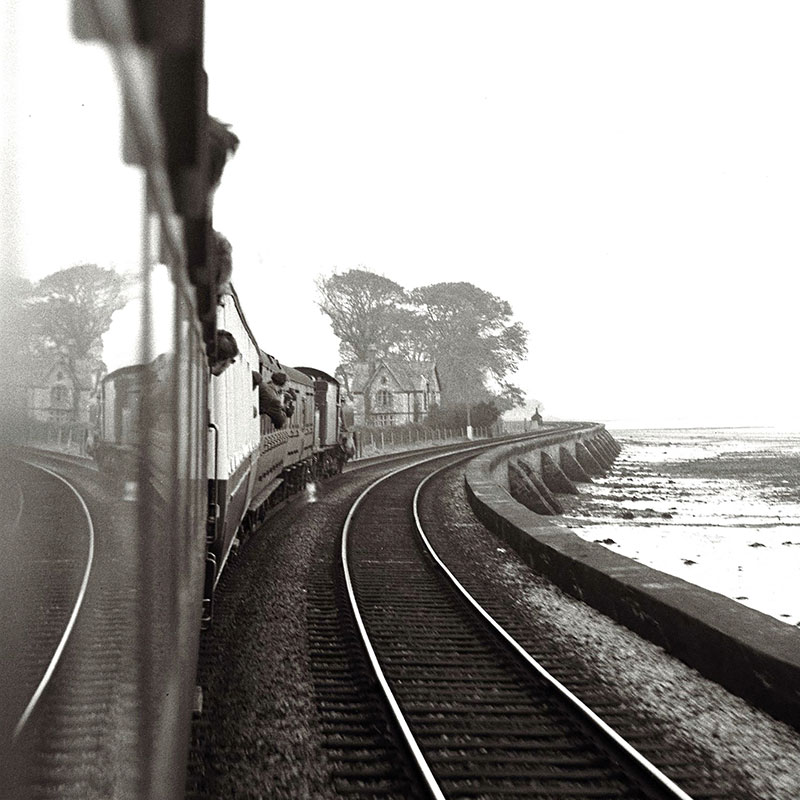
The train from Plymouth to Didcot runs alongside the river Teign on 2 December 1967
Hauled by No 6998 Burton Agnes Hall and No 1466, the little 0-4-2T was not expected to do much work, to economise on use of water between stops, apart from keeping the regulator open to maintain lubrication. The train consisted of a BR van filled with spare parts, all third No 5952, auto-trailer No 231 and Dreadnought No 3299.

The train at Westbury of 2 December 1967, the Dreadnought with its white-painted roof is prominent. Photograph by Adrian Vaughan
It was certainly an epic journey to move the stock which had hitherto been preserved at Totnes to its new home at Didcot. With British Rail’s new ban on steam haulage, it was expected that this would be the last steam train to leave Devon, but fortunately history has proved that wrong.
The oldest vehicle in the train, the 70ft long Dreadnought built in 1906, had hardly moved in many years since being parked at Newquay as a dormitory for restaurant car crews. When the train reached Newton Abbot the carriage and wagon inspector decided it was not fit to continue and wanted it removed from the train. GWS officials managed to persuade him to reverse that decision and the whole cavalcade successfully reached Didcot that cold, dark December evening. With the nucleus of the collection in the engine shed, the work of creating Didcot Railway Centre could begin.
TUESDAY 7 NOVEMBER
Launceston Signal Box 1943 Diagram
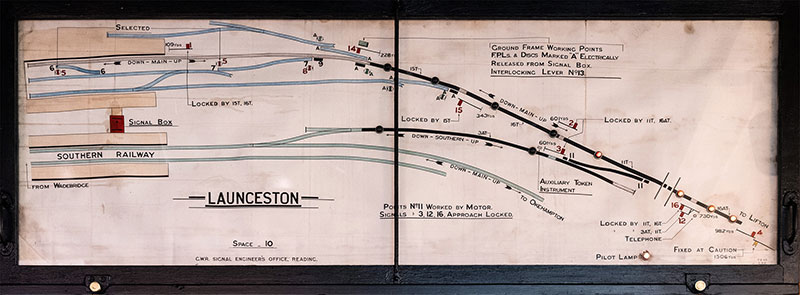
The Launceston diagram from 1943, now in the Signalling Centre at Didcot. The illuminated bulbs at bottom left indicate track circuits occupied by a train in a sequence to follow its movement
This small illuminated diagram from Launceston signal box in Cornwall was acquired by the Great Western Trust some years ago and was recently conserved and put on display in the Signalling Centre.
The diagram and case were made in Reading Signal Works in 1943 after it was decided to build a link between the GWR Plymouth to Launceston Branch and the Southern Railway line from Halwill Junction to Padstow, to ease troop and war material movements across the far south west.
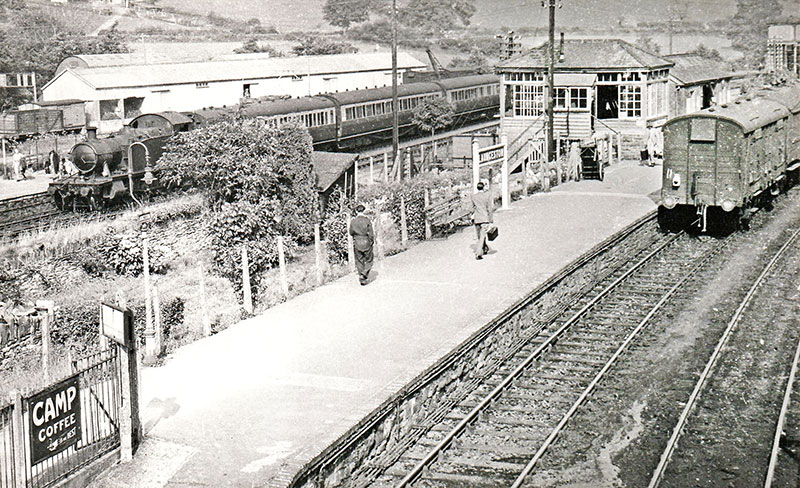
A view from the Southern Railway station with a train headed by a 4575 class 2-6-2T in the GWR station in the background. The back-to-back signal box is prominent on the SR platform
A similar scheme had been mooted in 1915, using the unusual signalling solution of combining both signal boxes at Launceston and Lydford by moving the GWR lever frames into back-to-back extensions of the existing L&SWR boxes – each staffed by a single L&SWR employee.
This novel idea was only possible because the stations were adjacent to each other. At Lydford connecting the two lines was relatively easy as there had been a temporary end-on connection there when the line from Meldon Junction opened, awaiting completion of the L&SWR’s extension to Plymouth via Bere Alston. At Launceston however, the job was more difficult and the connection had not been made before the Great War ended.

A lovely colour photograph from the Great Western Trust collection showing the Southern Region station at Launceston in the 1950s. Locomotive No 82025 was a BR Standard class 3 2-6-2T built in November 1954 at Swindon. The bright red telephone box and Post Office van add to the atmosphere
The diagram now in the Signalling Centre shows the layout controlled from a GWR 16 lever stud frame – the same design as the one in Frome Mineral Junction signal box now at Didcot. To avoid increasing the length of the frame in 1943, the goods yard connections were placed under the control of a ground frame released from the signal box, while the south side of the GWR station was simplified with hand points.

The Southern Region side of the back-to-back signal box. Photograph by Pat Garland
The new connection required track circuitry as the main facing point was beyond the limit for rod operation and not easily visible from the signal box. After the war its use declined until 1952 when the GWR station closed to passengers and trains to and from Plymouth used it to terminate in the Southern station, by then under BR(WR) control. After the closure of the Launceston Branch at the start of 1963, the connection was only used to access the goods facilities and the Ambrosia factory at Lifton. The signal box closed when all rail facilities at Launceston were withdrawn in 1966. The area languished for several years in an increasingly derelict condition until the 1980s when it was redeveloped into a business park.
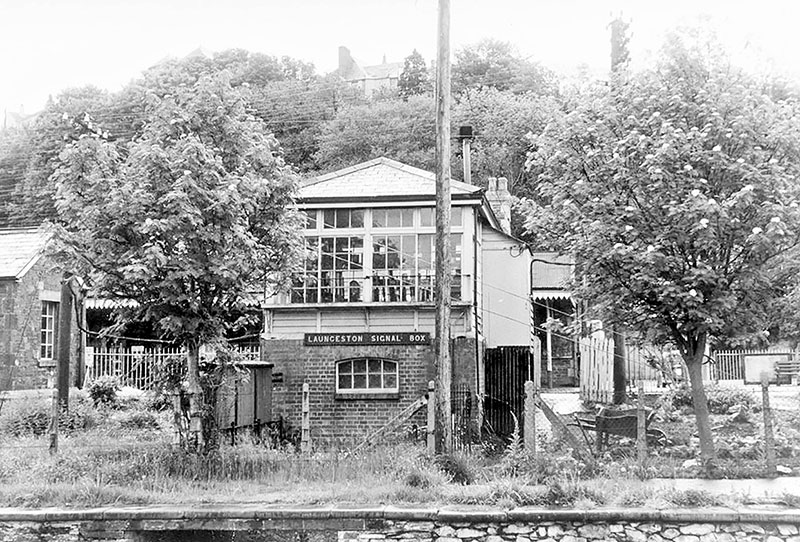
The Western Region side of the back-to-back signal box. Photograph by Pat Garland
The only sign today that there were ever two railways there is the Launceston Steam Railway: a narrow gauge concern which occupies the track bed immediately west of the L&SWR station for some distance towards Egloskerry.
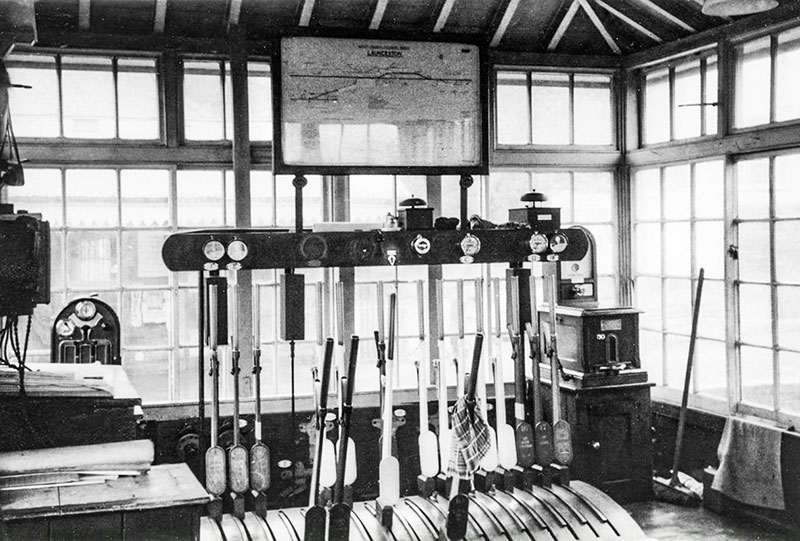
The lever frame inside the Southern Region side of the signal box. Photograph by D Wittamore
For its display the diagram has been illuminated in a sequence of typical train movements using a simulator designed and installed by Laurence Stant. No material alteration was made to the diagram or case, the original Mazda bullet bulbs have been stored inside the case, a note made of which track circuit they illuminated, and replaced with LED versions. The diagram itself is unaltered, the case only lightly restored and the simulator plumbed into the wiring using removable clips.
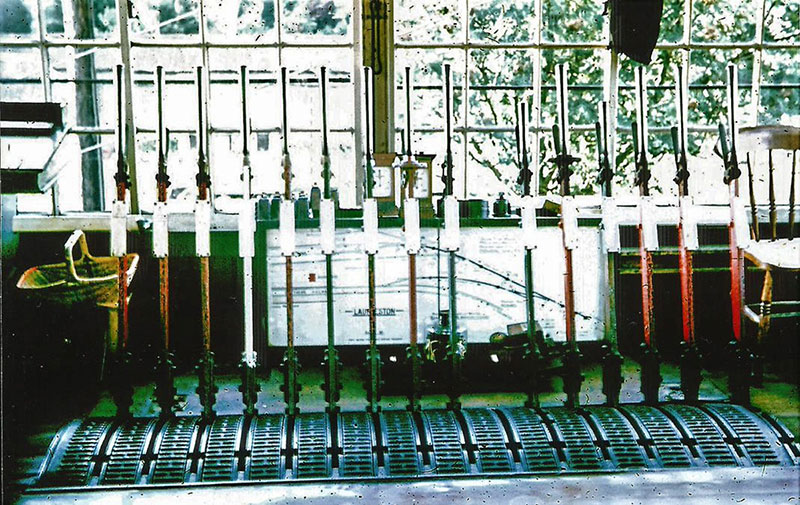
The Western Region lever frame photographed when the signal box was being dismantled, with the diagram (now exhibited at Didcot) lying on the floor. Photograph from the Jonathan Mann collection
Didcot Railway Centre Newsletter
Stay up to date with events and what's going on at Didcot Railway Centre.
You may unsubscribe at any time. We do not share your data with 3rd parties.